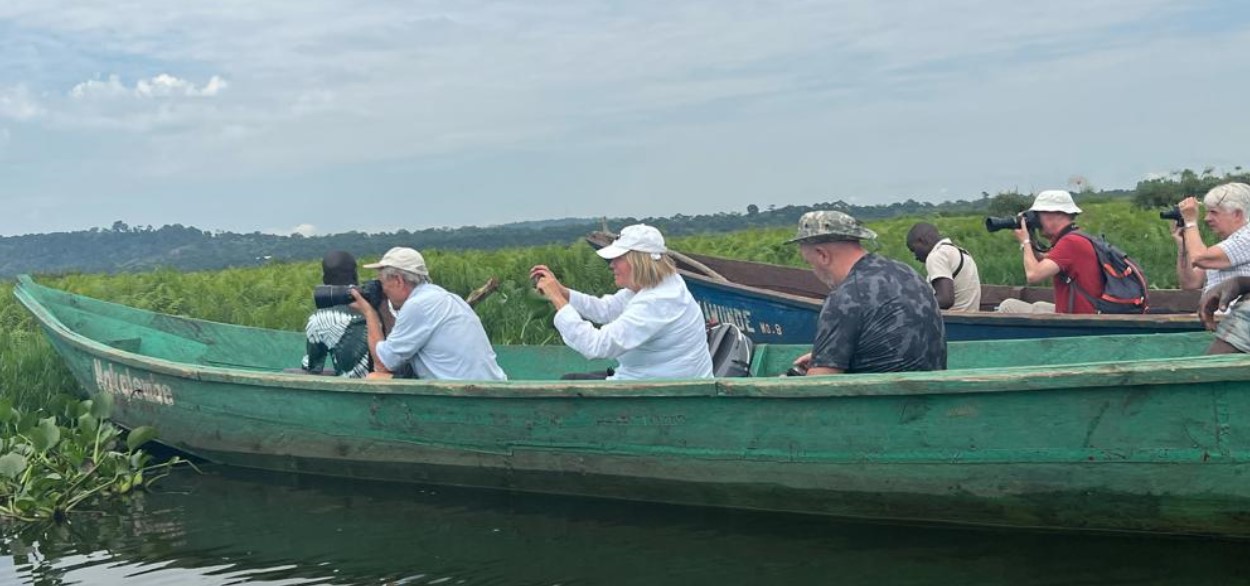
How to Access Mabamba Wetlands
How to Access Mabamba Wetlands: There is no doubt that Mabamba wetland is one of the popular wetland sites located about 38 km west of Entebbe Town. Due to its reach, habitats that range from papyrus swamps, shrubs, riverine vegetation, Amaranthus and aquatic vegetation cover, all act as breeding grounds for several bird species. The swamp is prominent for its classification as a vital ecosystem that supports biodiversity, local communities and conservation measures. Mabamba wetland is the best breeding ground for the Shoebill, it breeds in large groups on a vast papyrus swamp with its intricate network of channels and lagoons that can easily be accessed by motorised canoes. Additionally, the wetland has been classified as an Important Bird Area (IBA) by Birdlife International.
Bird species to see in Mabamba
Besides the threatened Shoebill Stork, Mabamba Wetland is home to numerous bird species, including the traditional East African water birds such as the African Fish Eagle, Fantailed Widowbird, Malachite Kingfisher, White-backed and Yellow-billed Duck, Rufous-bellied, Purple, Black-headed and Goliath Heron, African Water Rail, Northern-brown Throated Weaver, Long-tailed Cormorant, African Marsh-Harrier, Winding Cisticola and Allen’s Gallinule. Together with a few species that are a little more local, such as the long-toed Plover and Blue-breasted Kingfisher, Blue-breasted Bee-eater, Papyrus Gonolek, Papyrus Canary, White-winged, Lesser, and Greater Swamp Warbler, Blue-headed Coucal, and Swamp Flycatcher and among others.
How to Access Mabamba Wetlands
By Road
This is one of the simplest routes to access Mabamba Wetlands, particularly if you would rather travel by land. The quickest route to Mabamba is via the Nakiwogo landing site in Entebbe, which is accessible by car from Kampala or Entebbe. After a ten-minute boat ride to Kasanje dock, drive for approximately twenty minutes to reach Mabamba. You will see open fields and cultivations throughout the route, giving you lots of chances to watch garden birds.
How to access Mabamba wetlands By Boat
The Mabamba wetlands can also be accessed by boat, especially when using motorised canoes, among other means. Choosing a boat transfer from Entebbe town is highly recommended. Compared to driving, this approach ensures excellent bird viewing. You can see a lot of different birds on the route across Lake Victoria, such as the Blue Swallow, the White-winged Warbler, Carruther’s Cisticola, and the Grosbeak Weaver, among others. The boat adventure, which is primarily conducted in a dug-out canoe, lasts between four and five hours. Keep in mind that the Shoebill can be viewed all day long, but it is most obvious in the morning when it stalks its primary prey, mudfish or frogs.
Importance of Mabamba Wetlands and the environs
It acts as a breeding ground for fish such as tilapia, lung fish, and several bird species, such as the unique Shoebill Stork, due to its rich vegetation cover of papyrus that supports birdlife for species like the Papyrus Gonolek, Long-toed Plover, Blue-breasted Kingfisher and many others.
The wetland plays a critical role in supporting the local communities, particularly those in the vicinity of the wetlands, through a variety of economic endeavours, including agriculture, fishing, site guiding, potters, and a variety of crafts such as baskets, papyrus mats, and brooms manufactured from papyrus reeds. Both the community’s welfare and living standards are intended to be improved by this.
How to access Mabamba Wetlands: In the bid to access this treasured swamp for birdwatching, nature walks, birding photography, and boat rides, it helps to secure its sustainability as one of the leading birding spots for the elusive shoebill in Uganda, thus attracting birders from different parts of the world to the country.
Due to its rich birdlife habitats, it is also home to a wide variety of bird species. The vegetation cover allows a number of bird species, including the endangered Shoebill Stork, which thrives in these marshy areas, to seek sanctuary in this valuable wetland.
In particular, the vegetation cover, which is dominated by papyrus swamps, benefits from the swamp’s assistance in filtering and sieving water. Lake Victoria, the biggest freshwater lake in Africa, and other natural water bodies, including swamps, rivers, and lakes, benefit from this, as well as human-use water purification and quality regulation.
Mabamba Wetland is one of the well-known swamps where aquatic research is conducted for educational and scientific objectives. This research is primarily focused on environmental conservation, plant species, breeding and nesting sites of various bird species, including shoebills and papyrus gonolek, and fish species, including tilapia and lungfish. Thus, access to Mabamba Wetland is the best way to explore and learn about the natural setting and heritage of this popular swamp.
Take a birdwatching trip in Uganda to see over 1,061 different bird species that live in this diverse nation, in addition to Shoebills. Uganda is home to several amazing bird species, including the African Finfoot, Green-breasted Pitta, and Papyrus Gonolek. Our knowledgeable bird guides make sure you get the most out of your birdwatching experience, and we help preserve these amazing species and their wetland habitats by giving back to the community. Uganda is the ideal destination if you have a strong interest in the natural world and its fauna.
